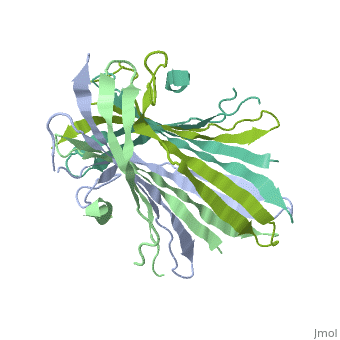User:Vinícius M. Neto/Sandbox 1
From Proteopedia
(Difference between revisions)
| Line 8: | Line 8: | ||
Silk fibers from [https://en.wikipedia.org/wiki/Bombyx_mori Bombyx mori] (silkworm) have been utilized by mankind since ancient times due to their remarkable mechanical properties and comfort when woven into fabrics, with the earliest records dating to around 2700 BC <ref>DOI 10.1201/9781420015270</ref>. They are thermally comfortable, elastic, strong, and soft—properties that make silk highly sought after as a luxury fabric for garments. Silk is also biocompatible, making it applicable as a medical biomaterial for sutures, drug delivery systems, and scaffolds, where it plays a vital role in tissue regeneration<ref>DOI 10.1038/nprot.2011.379</ref>. | Silk fibers from [https://en.wikipedia.org/wiki/Bombyx_mori Bombyx mori] (silkworm) have been utilized by mankind since ancient times due to their remarkable mechanical properties and comfort when woven into fabrics, with the earliest records dating to around 2700 BC <ref>DOI 10.1201/9781420015270</ref>. They are thermally comfortable, elastic, strong, and soft—properties that make silk highly sought after as a luxury fabric for garments. Silk is also biocompatible, making it applicable as a medical biomaterial for sutures, drug delivery systems, and scaffolds, where it plays a vital role in tissue regeneration<ref>DOI 10.1038/nprot.2011.379</ref>. | ||
| - | [[Fibroins|Fibroins]] are fibrous structural proteins composed of multiple subunits that assemble into high-strength materials like [https://en.wikipedia.org/wiki/Silk silk] and [https://en.wikipedia.org/wiki/Byssus byssal threads]. The exact composition varies by organism but typically features core fibroin filaments bundled within a sericin coating. These core filaments consist of three key components: a heavy chain (FibH), a light chain (FibL), and glycoproteins, all stabilized by disulfide bonds. The N-terminal domain of FibH (FibNT) plays a crucial role in the pH-dependent assembly of fibroin molecules during fiber formation <ref name="PDB">DOI 10.1016/j.jmb.2012.02.040</ref>. | + | [[Fibroins|Fibroins]] are fibrous structural proteins composed of multiple subunits that assemble into high-strength materials like [https://en.wikipedia.org/wiki/Silk silk] and [https://en.wikipedia.org/wiki/Byssus byssal threads]. The exact composition varies by organism but typically features core fibroin filaments bundled within a sericin coating. These core filaments consist of three key components: a heavy chain (FibH), a light chain (FibL), and glycoproteins, all stabilized by disulfide bonds. The N-terminal domain of FibH (FibNT) plays a crucial role in the pH-dependent assembly of fibroin molecules during fiber formation <ref name="PDB">DOI 10.1016/j.jmb.2012.02.040</ref> (see [[#pH-Dependent Structural Transition|pH-Dependent Structural Transition]] section). |
== Biological production == | == Biological production == | ||
Revision as of 16:48, 19 June 2025
FibNT (3UA0)
| |||||||||||
References
- ↑ doi: https://dx.doi.org/10.1201/9781420015270
- ↑ doi: https://dx.doi.org/10.1038/nprot.2011.379
- ↑ 3.0 3.1 He YX, Zhang NN, Li WF, Jia N, Chen BY, Zhou K, Zhang J, Chen Y, Zhou CZ. N-Terminal Domain of Bombyx mori Fibroin Mediates the Assembly of Silk in Response to pH Decrease. J Mol Biol. 2012 Mar 1. PMID:22387468 doi:10.1016/j.jmb.2012.02.040

